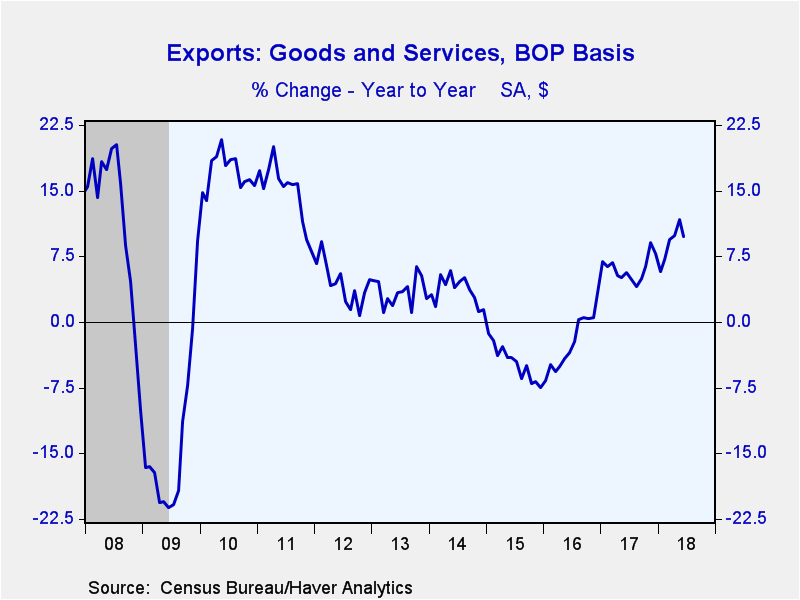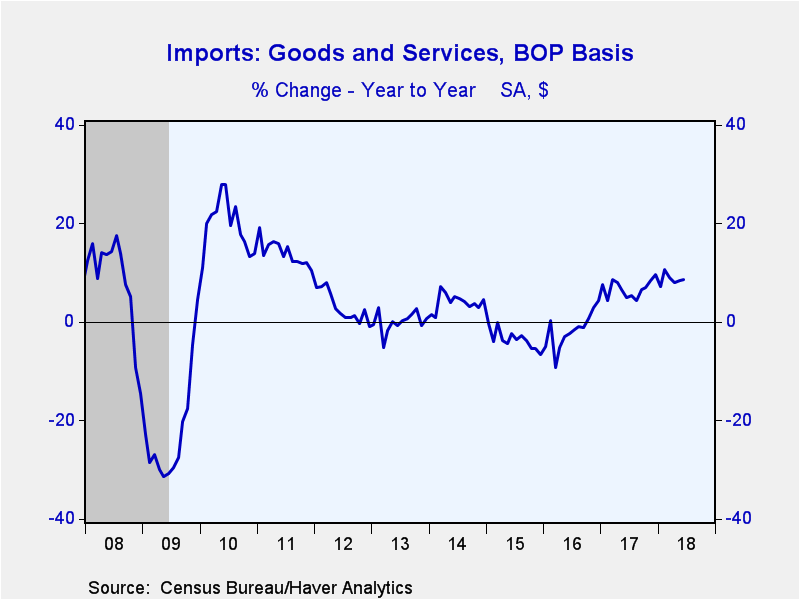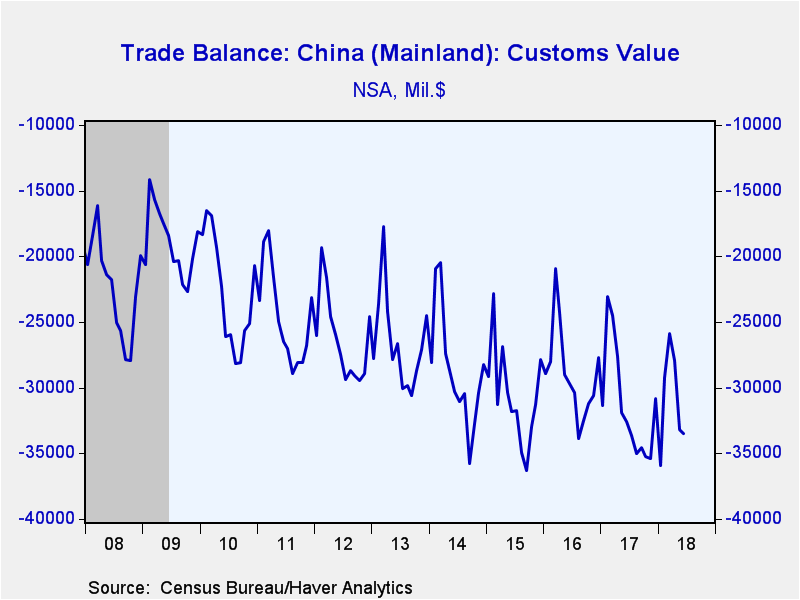 Global| Aug 03 2018
Global| Aug 03 2018U.S. Trade Deficit Widens in June
Summary
The U.S. trade deficit in goods and services widened to $46.3 billion in June from May’s $43.2 billion; May was revised marginally from $43.1 billion. The June result was quite close to the Action Economics Forecast Survey estimate of [...]
The U.S. trade deficit in goods and services widened to $46.3 billion in June from May’s $43.2 billion; May was revised marginally from $43.1 billion. The June result was quite close to the Action Economics Forecast Survey estimate of $46.2 billion. Exports fell 0.7% month-on-month (+9.8% year-on-year) following a 1.9% gain. Imports were up 0.6% (8.6% y/y) after a 0.5% increase.
The deficit on goods trade widened to $68.8 billion in June from $65.7 billion in May. Exports of goods fell 1.2% (+11.4% y/y) following a 2.7% rise. Nearly all the end-use categories saw noticeable declines: foods, feeds & beverages by 0.3% (23.9% y/y), capital goods by 1.9% (7.7% y/y), automotive vehicles and parts, 5.2% (-5.1% y/y), non-auto consumer goods, 8.1% (-0.9% y/y) and “other”, 9.8% (10.9% y/y). The notable exception is industrial supplies and materials, which includes petroleum exports; that grouping gained 4.4% (22.8% y/y).
Imports of goods rose 0.7% (9.0% y/y) in May following a 0.5% increase. Several end-use categories had declines: capital goods, which had gained 3.6% in May, fell back by 2.5% in June (+8.6% y/y). “Other” goods imports decreased 2.1% (+3.5% y/y) and foods, feeds & beverages fell 1.7% (+6.7% y/y). There were some notable increases in goods imports: non-auto consumer goods imports rose 3.8% (8.8% y/y) and automotive vehicles & parts were up 1.7% (-0.1% y/y). Also, industrial supplies & material increased 1.9% (18.6% y/y). This last group includes petroleum.
Petroleum imports advanced 4.2% (+37.7% y/y) following a dip of 0.7%. The per-barrel cost of crude oil rose from $58.37 in May to $62.42 in June (37.4% y/y), the highest price since $73.60 in December 2014. The value of energy-related petroleum product imports jumped 2.1% in June (33.9% y/y) while the quantity of energy-related product imports dropped 1.8% (-4.9% y/y).
We’ve added exports of petroleum goods to the summary table below, as U.S. activity in that direction has increased markedly since late-2016/early-2017. In June, the value of such exports increased 8.5% (57.7% y/y) after just 0.7% in May. Some of that movement is, of course, in the price, but even so, in chained 2012 dollars, exports of petroleum goods gained 6.5% in June and 17.5% year-on-year.
The surplus on services trade edged down in June to $22.46 billion from $22.51 billion in May. Services exports increased 0.3% (6.6% y/y) after a 0.5% gain. The largest categories of service exports all continued to grow: travel 0.2% (2.9% y/y), nonfinancial business services 0.3% (8.3% y/y), intellectual property 0.2% (5.3% y/y) and financial services 0.8% (11.4% y/y).
Imports of services rose 0.5% (+6.7% y/y) after a 0.3% gain. The main upward factor was charges for intellectual property, which gained 5.6% in June and 26.3% year-on-year. Other services Imports were fairly mixed: non-financial business services rose 0.3% (9.8% y/y) while transport charges decreased 0.2% (+4.1% y/y). U.S. residents' travel abroad eased 0.2% (+5.7% y/y).
The goods trade deficit with China widened to $33.5 billion in June from $33.2 in April. Exports to China rose 14.4% y/y while imports from there were up 5.5% y/y. The deficit with the European Union narrowed to $11.7 billion from $13.4 billion; exports increased 19.9% y/y and imports 10.7% y/y. The trade deficit with Japan narrowed slightly to $5.3 billion from $5.5 billion as exports grew 11.7% y/y and imports rose 3.1% y/y.
The international trade data can be found in Haver's USECON database. Detailed figures are available in the USINT database. The expectations figures are from the Action Economics Forecast Survey, which is carried in AS1REPNA.
| Foreign Trade in Goods & Services (Current $) | Jun | May | Apr | Y/Y | 2017 | 2016 | 2015 |
|---|---|---|---|---|---|---|---|
| U.S. Trade Deficit ($ bil.) | 46.35 | 43.19 | 46.08 | 44.80 (6/17) |
552.28 | 502.00 | 498.53 |
| Exports of Goods & Services (% Chg) | -0.7 | 1.9 | 0.3 | 9.8 | 6.1 | -2.2 | -4.6 |
| Petroleum (% Chg) | 8.5 | 0.7 | 5.9 | 57.7 | 41.2 | -9.6 | -32.5 |
| Imports of Goods & Services (% Chg) | 0.6 | 0.5 | -0.2 | 8.6 | 6.8 | -1.7 | -3.5 |
| Petroleum (% Chg) | 4.2 | -0.7 | 5.0 | 37.7 | 27.2 | -19.5 | -45.5 |
| Nonpetroleum Goods (% Chg) | 0.4 | 0.6 | -0.9 | 6.8 | 5.6 | -1.2 | 2.2 |
Carol Stone, CBE
AuthorMore in Author Profile »Carol Stone, CBE came to Haver Analytics in 2003 following more than 35 years as a financial market economist at major Wall Street financial institutions, most especially Merrill Lynch and Nomura Securities. She has broad experience in analysis and forecasting of flow-of-funds accounts, the federal budget and Federal Reserve operations. At Nomura Securites, among other duties, she developed various indicator forecasting tools and edited a daily global publication produced in London and New York for readers in Tokyo. At Haver Analytics, Carol is a member of the Research Department, aiding database managers with research and documentation efforts, as well as posting commentary on select economic reports. In addition, she conducts Ways-of-the-World, a blog on economic issues for an Episcopal-Church-affiliated website, The Geranium Farm. During her career, Carol served as an officer of the Money Marketeers and the Downtown Economists Club. She has a PhD from NYU's Stern School of Business. She lives in Brooklyn, New York, and has a weekend home on Long Island.









